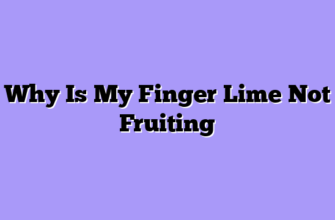Have you ever bitten into something that literally explodes with flavor in your mouth? That’s exactly what happened the first time I tasted a finger lime from my own trees. These remarkable plants, scientifically known as Citrus australasica, have completely revolutionized my approach to specialty fruit cultivation. Whether you call them caviar limes, Australian finger limes, or by their Aboriginal name “rainforest pearls,” these thorny beauties have become the crown jewels of my orchard.
Growing finger lime trees isn’t just about cultivating another citrus variety – it’s about understanding a completely different philosophy of fruit production. These native Australian plants, also known locally as “limebush” or “native citrus,” have taught me that sometimes the most challenging crops yield the most rewarding results. Let me share my journey with these extraordinary trees and why I believe they represent the future of premium fruit growing.
When I first encountered Citrus australasica at a specialty growers’ conference, I was skeptical. Could a thorny shrub that looks more like a wild hedge really produce fruits worth $50 per pound? The answer, as I’ve discovered through countless scratches, pruning sessions, and harvest days, is a resounding yes. But success with finger lime trees requires patience, precision, and a willingness to think outside the conventional citrus box.
Understanding the Unique Nature of Finger Lime Trees
Finger lime trees aren’t your typical backyard citrus. These plants evolved in the subtropical rainforests of Queensland and New South Wales, where they grow as understory shrubs beneath the forest canopy. This evolutionary background explains everything about their growing requirements – and why so many first-time growers struggle with them.

The trees themselves are surprisingly variable in size and form. Some varieties stay compact at 6-8 feet, perfect for container growing or small spaces. Others can reach 25 feet if left unpruned, creating an impenetrable thicket that’s both beautiful and intimidating. What they all share is that distinctive finger-shaped fruit that gives them their common name.
Inside those finger-shaped fruits lies the real magic – thousands of tiny vesicles that burst with intense citrus flavor. It’s like nature created its own version of molecular gastronomy long before chefs ever thought of it. Each vesicle is a perfect little sphere of concentrated lime essence, and when you bite down, they literally pop in your mouth like tiny flavor bombs.
Finger Lime Tree Characteristics by Variety
| Variety | Tree Size | Fruit Size | Harvest Season | Best Growing Zones |
|---|---|---|---|---|
| Red Champagne | 8-12 ft | 3-4 inches | Fall-Winter | 9-11 |
| Emerald | 10-15 ft | 2-3 inches | Summer-Fall | 8-11 |
| Pink Ice | 6-10 ft | 3-4 inches | Winter-Spring | 9-11 |
| Byron Sunrise | 12-18 ft | 4-5 inches | Fall-Winter | 9-11 |
| Crystal | 8-14 ft | 2-3 inches | Year-round | 8-11 |
The market response to these fruits has been nothing short of phenomenal. When I started growing caviar limes, I was targeting local farm-to-table restaurants. Now I have waiting lists from high-end establishments across three states, and my wholesale prices have tripled. The reason? Supply simply cannot keep up with demand from chefs who’ve discovered that these little pearls can transform everything from seafood dishes to craft cocktails.
Mastering the Art of Finger Lime Cultivation
Growing finger lime trees successfully requires abandoning everything you think you know about citrus cultivation. These plants march to their own drummer, and fighting their natural tendencies is a recipe for frustration. I learned this lesson the hard way when I initially tried to train them like conventional citrus trees.

Soil preparation is where many growers go wrong. These trees absolutely demand excellent drainage – they’re more sensitive to waterlogged conditions than almost any other citrus. I’ve found that raising the planting area by 6-8 inches and amending with coarse bark, perlite, and compost creates the perfect growing medium. Think of it as creating a forest floor environment rather than typical agricultural soil.
Essential Growing Requirements:
- Soil pH: 6.0-6.5 (slightly more acidic than typical citrus)
- Drainage: Excellent – these trees hate wet feet
- Light: Filtered sunlight or morning sun with afternoon shade
- Temperature: Hardy to 25°F (-4°C) once established
- Humidity: Moderate to high, especially during fruit development
- Spacing: 8-12 feet apart for optimal air circulation
The pruning approach for finger lime trees is completely different from conventional citrus. Instead of trying to create an open center like you would with an orange tree, I’ve learned to work with their natural shrub-like growth pattern. Light pruning to remove dead wood and improve air circulation works best. Heavy pruning can actually reduce fruit production and make the plants more susceptible to disease.
Propagation and Rootstock Selection
One of the most fascinating aspects of working with finger lime trees is the propagation process. While you can grow them from seed, the results are completely unpredictable – you might wait five years only to discover your tree produces tiny, bitter fruits. Grafting is the way to go for commercial production, but it requires understanding which rootstocks work best with Citrus australasica.
Here’s my experience with different rootstock combinations:
- Trifoliate Orange – Provides excellent cold hardiness and dwarfs the tree size
- Flying Dragon – Creates compact trees perfect for containers or small spaces
- Rough Lemon – Promotes vigorous growth but can be less cold hardy
- Carrizo Citrange – Offers good disease resistance and soil adaptability
- Standard Citrus – Works well but may not provide optimal performance
The grafting process itself is more challenging with finger limes than with conventional citrus. The wood tends to be harder and more brittle, and the success rate is lower. I’ve found that grafting during cooler weather and protecting the graft union from direct sunlight significantly improves success rates.
Market Dynamics and Economic Potential
Let’s talk about the elephant in the room – the economics of finger lime production. These trees represent one of the most profitable specialty crops I’ve ever grown, but they’re not a get-rich-quick scheme. The initial investment is substantial, the learning curve is steep, and patience is absolutely essential.
The market for finger limes has exploded over the past decade. What started as a niche product for molecular gastronomy has expanded into mainstream fine dining, specialty cocktails, and gourmet home cooking. The global finger lime market is currently valued at approximately $35 million and growing at nearly 15% annually.
Production Economics Analysis
| Factor | Cost/Revenue | Timeline | Notes |
|---|---|---|---|
| Grafted tree cost | $35-60 | Initial | Quality matters significantly |
| Annual maintenance | $25-40 per tree | Ongoing | Pruning, fertilizing, pest control |
| Time to production | 2-3 years | – | Container plants produce sooner |
| Average yield (mature) | 20-35 lbs/tree | Annual | Varies by variety and care |
| Wholesale price | $20-45/lb | Seasonal | Premium varieties command higher prices |
| Direct sales price | $35-70/lb | Seasonal | Restaurants pay premium for quality |
| ROI timeline | 4-5 years | – | Including establishment costs |
The pricing structure for finger limes is unlike any other fruit I’ve grown. Different varieties command vastly different prices based on their unique characteristics. Red Champagne and Pink Ice varieties, with their striking appearance and mild flavor, fetch premium prices from restaurants focusing on visual presentation. Emerald varieties, while less expensive, offer reliable production and consistent quality that appeals to volume buyers.
What really excites me about this market is the diversity of applications. I’ve sold finger limes to:
- High-end restaurants for garnishing seafood and creating unique flavor profiles
- Craft cocktail bars using them as natural “caviar” garnishes
- Specialty food manufacturers incorporating them into sauces and preserves
- Home gardeners and cooking enthusiasts seeking unique ingredients
- Wedding planners looking for distinctive catering elements
The key to maximizing profitability is understanding your target market and building relationships before your trees reach full production. I spend considerable time visiting restaurants, attending food shows, and networking with chefs to understand exactly what they’re looking for in terms of size, flavor, and presentation.
Harvesting Challenges and Post-Harvest Success
Harvesting finger limes is an art form that combines timing, technique, and pain tolerance. Those thorns I mentioned earlier? They’re not just a minor inconvenience – they’re a serious occupational hazard that requires proper equipment and careful planning.
The timing of harvest is absolutely critical. Unlike conventional citrus where you have a fairly wide harvest window, finger limes need to be picked at exactly the right moment. Too early, and the vesicles haven’t developed their characteristic “pop.” Too late, and they become mushy and lose their textural appeal. I test for ripeness by gently pressing the fruit – it should give slightly but still feel firm.
The actual harvesting process requires specialized equipment. I use telescoping pruning shears for higher fruits and heavy-duty gloves that extend well up the forearm. Even with protection, I’ve collected more scratches from finger lime trees than from all my other crops combined. The fruits tend to hide within the thorny branches, making each harvest a treasure hunt.
Post-harvest handling is where many new growers struggle. Finger limes are surprisingly delicate despite their tough exterior. They need immediate cooling to 32-35°F and high humidity storage. I’ve found that perforated plastic bags work best for maintaining humidity while allowing air circulation.
One interesting discovery I’ve made is that finger limes continue to develop flavor for several days after harvest when stored properly. This post-harvest flavor development is unusual for citrus and allows me to time my harvests for optimal flavor delivery to customers.
The shelf life varies significantly by variety and handling. Under ideal conditions, finger limes maintain quality for 4-6 weeks, but the vesicle texture begins to deteriorate after about 3 weeks. This makes logistics and customer communication absolutely crucial – I’ve learned to coordinate harvest timing with delivery schedules to ensure customers receive fruit at peak quality.
Looking Forward: The Future of Finger Lime Growing
As I reflect on my journey with finger lime trees, I’m constantly amazed by their potential and the challenges they continue to present. The market demand shows no signs of slowing, and new varieties are being developed that promise improved characteristics – better cold tolerance, thornless options, and unique flavor profiles.
The sustainability aspect of finger lime production particularly appeals to me. These trees require less water than conventional citrus, show natural resistance to many common pests, and can be integrated into agroforestry systems that benefit overall farm biodiversity. As environmental concerns become increasingly important to consumers, crops like finger limes that align with sustainable farming practices will likely see continued market growth.
However, the industry faces some significant challenges. As more growers enter the market, maintaining quality standards will be crucial for preserving the premium positioning of finger limes. There’s also the risk of market saturation if production scales up too quickly relative to demand growth.
My advice to anyone considering finger lime cultivation is straightforward: start small, focus obsessively on quality, and build customer relationships before your first tree reaches maturity. This isn’t a commodity crop – success requires understanding your market and delivering consistently exceptional fruit.
The finger lime tree has taught me that sometimes the most rewarding crops are the ones that challenge conventional thinking. These thorny, temperamental plants have shown me that innovation in agriculture often comes from embracing the difficult and the different. Whether you call them caviar limes, Australian finger limes, or rainforest pearls, Citrus australasica represents the kind of specialty crop that can transform both a farming operation and a farmer’s perspective on what’s possible.
Just remember – invest in really good gloves, and don’t be discouraged by the scratches. The reward of watching customers’ faces light up when they taste your finger limes for the first time makes every thorn worth it.








